
How Stephen Gould Scaled Its Capacity by 30% without Making a Single Hire
What are SMART goals and why businesses today find it important to know and use them in their everyday operations? Read on for the guide on how to use SMART goals and build the track to win the race on.
What do you do when an idea sparks around something that you want to achieve?
Answers can vary here. But I can tell you what you need to do: take the right steps to get there.
SMART goals are a goal-setting method established through a specific set of criteria, ensuring all objectives are achievable within a particular time frame. SMART as an acronym stands for:
With slightly different variations, these five components of a goal need to be present if we want to apply SMART goals to our business strategy. Through this approach, any generalities of a goal are eliminated and clear action plans can be easily set. By setting a clear timeline and objectives, progress is tracked more efficiently and roadblocks are identified right on time. Setting SMART goals means setting your business up to achieve its goals in a very specific, clear-cut way.
With SMART goals, specific targets are being determined and chased, as opposed to going after something in more general terms, without having a precise idea of what the specific steps to that “something” looks like.
That means teams know from the beginning what specific actions to take, with no confusion and a sharp vision of the goal and the smaller sub-goals that need to happen before achieving it fully.
We’ve already established that SMART goals are a way for businesses to evolve from the too vague or poorly framed goal-setting process they might be using. However, each letter in the name has its own particular purpose that gives a good idea of what this approach is all about on a more practical level. So let’s take a look at them separately.
• S for Specific: this is the characteristic that narrows what needs to be done – every step necessary – to achieve the set goal. The more narrow the goal, the less chance for blockages and loss of progress along the way.
• M for Measurable: setting measurable sub-goals allows you to course-correct at any point, by evaluating the progress with facts and numbers. If you know for example what percentage open rate you need for your emails in a certain marketing campaign, you can check and remodel your strategy in due time and in a meaningful way so you can get the results and numbers you are striving for.
• A for Achievable: when goals are set reasonably and all additional steps are clear, goals are achieved much faster and with team motivation with due dates and transparent responsibility.
• R for Relevant: the goals should reflect and align with the goals of the company and it should be clear how they correspond to the long-term goals of the organization
• T for Time-Based: an end-date helps immensely with prioritization and clears away everything unrealistic – the set and clear time frame helps to apply the necessary effort at the right time
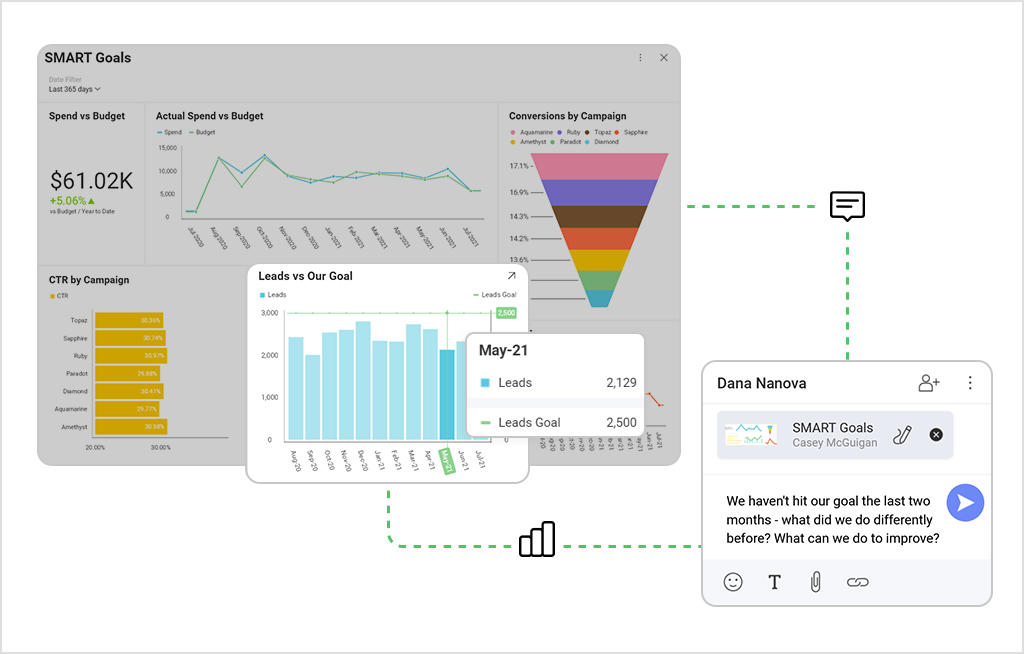
To start building your company’s goals in a meaningful way, SMART goals setting might be the way to set a clear timeline and track progress so that milestones are achieved quickly and with ease.
Using those five components and setting goals for your organization by choosing the right definitions, setting realistic timing, and giving your team the clearest possible outline of the way forward they need. That way, you eliminate the lack of clarity and the sense of urgency that can sometimes truly kill productivity.
Knowing that SMART goals are important is not enough – to drive success in your team and organization, you need to understand how to use them correctly. Here are some of the ways you can achieve that in the daily work of your business and integrate it within the performance of your team.
• Team collaboration all the way – SMART goals have the best chance to work and succeed in driving success forward if teammates are working within the frame of this approach and communicate openly
• Use performance management software – do this to keep track of your progress towards achieving the metric goals you have set. This gives clear transparency to your teams and organization at any point in your project or campaign. These goals could be related to a launch of a campaign, a paid campaign management, or perfecting your content calendar in a marketing environment
• Have intention and criteria – goal-achieving depends on teams, and teams depend on clarity. If you let your team know the criteria beforehand and give them the incentive to use SMART goals effectively, they will carry it forward like true ambassadors for the method
• Keep track of goals hit – and reward it: always be aware of what percentage of your SMART goals is achieved and what bumps you’ve hit along the way while rewarding the achievements and stacking accomplishment record
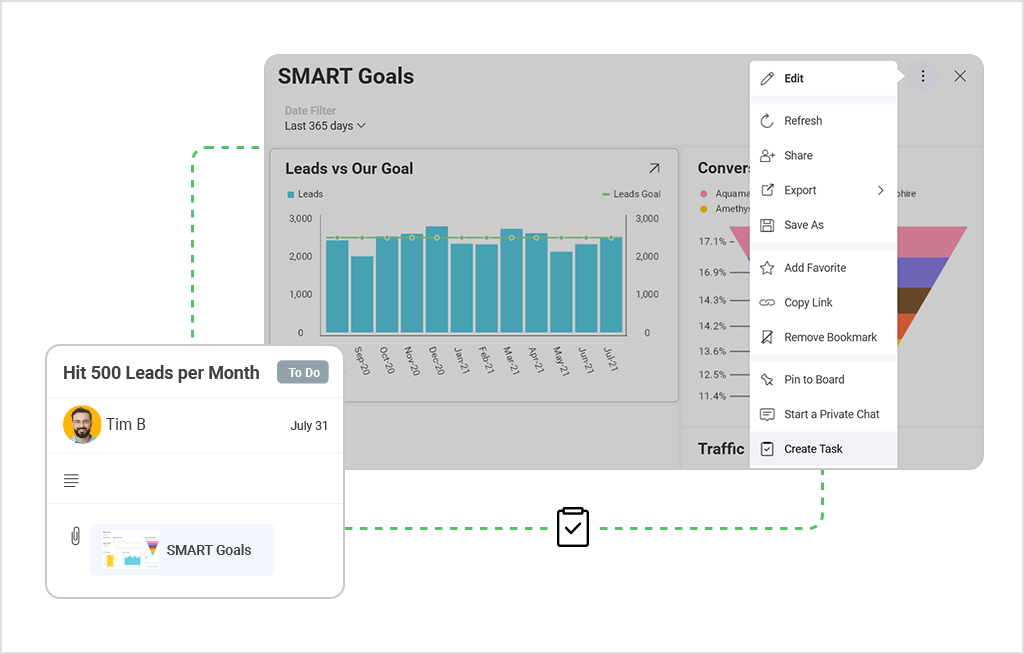
To answer simply: the importance of SMART goals lies in their ability to increase the odds of success by making sure a goal – any goal – is attainable and identifying the metrics by which that is defined. That not only takes the pressure off when deciding where to put efforts and time next but also shows the clear roadmap to getting there. Here are some of the issues SMART goals resolve.
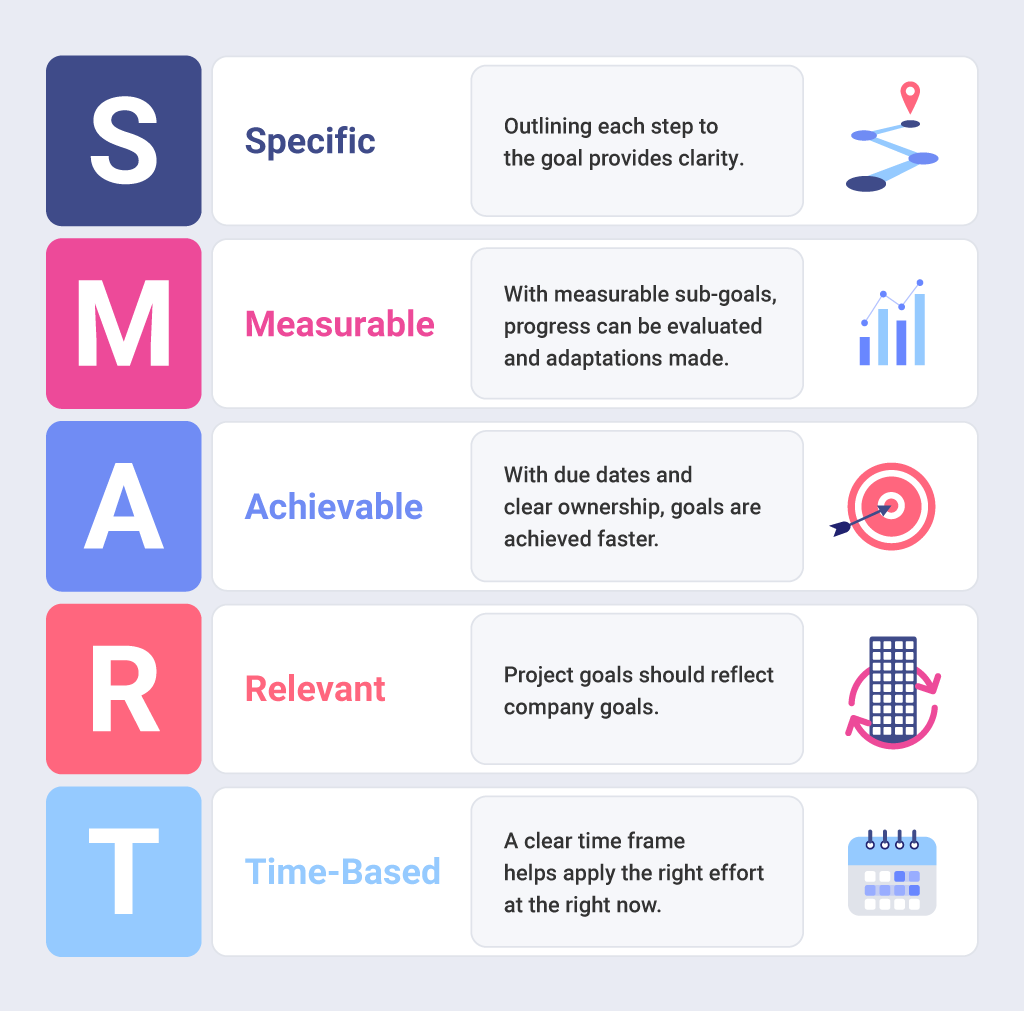
• Uncertainty – if you are sick of always having only a vague idea of how to get somewhere, SMART goals are the way to go – they give clear intention and eliminate guesswork when setting the path ahead
• No clear benchmarks – without them, organizations are just going forward in darkness; with SMART goals, future success is defined by setting the desired outcome in terms of metrics beforehand
• Unclear outline of the objective – many times the goal is so obscure that teams struggle to deliver the expected result and oftentimes end up doing it all over again. Through SMART goals each team member can recognize realistic and achievable purposes and go after them with no delay or hesitation
• Dragging and delays – SMART goals let teams thrive by providing clarity not only in metrics and details for the goal but through clearly set timeframes in which any of these need to happen
The truth of the matter is, what can really trip the progress of your team up is abstract goals that create chaos and even loss of revenue and man-hours spent pointlessly.
Accomplishing SMART goals is the intelligent way to grab opportunities without going into turmoil over how to get them to happen. SMART goals give you the concrete steps to the goal and cement the outcome with clear and factual details on what needs to happen and at what point in time.
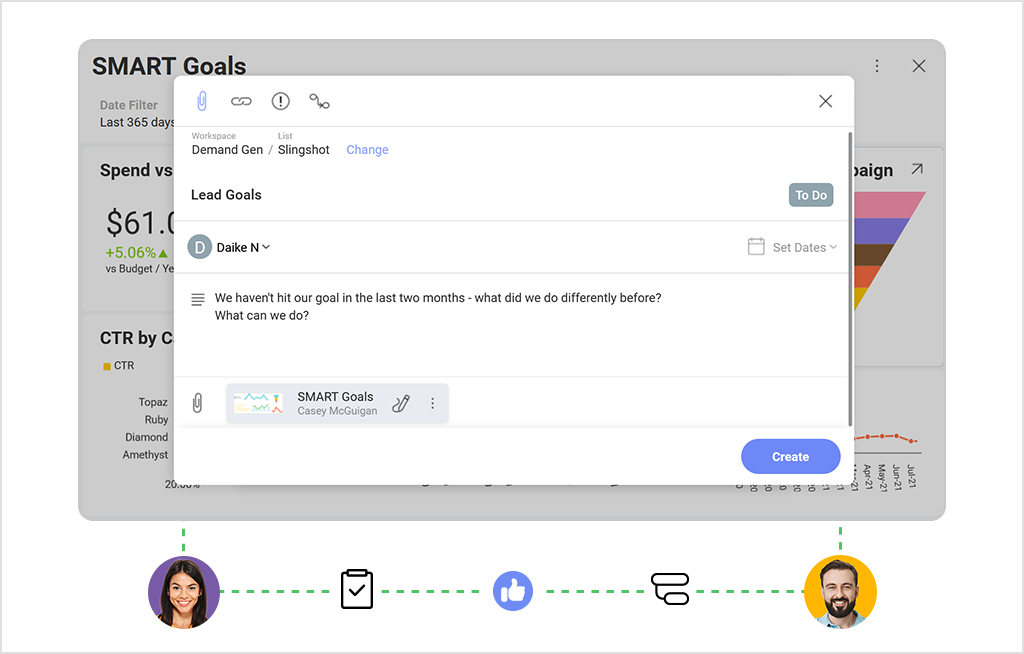
Before you start working according to your SMART goals, you need to formulate them – smartly. To succeed in this, you must again look at the acronym itself – Specific, Measurable, Achievable, Relevant, and Time-Bound – and take each of these to build the goals write-up correctly. So here are 5 important steps you need to take and some examples on how to write SMART goals, and give them specific descriptions so that they work perfectly for your team.
1. Specify the desired outcome for every step.
For example, an unspecific description here would be “I want to have better alignment in my team”, and a specific one – “I want my team to have at least one team meeting a week and communicate closely in one place during the workday.” Setting the proper specifications is the key to pointing the torch in the darkness of vagueness.
2. Specify by what metrics this goal will be evaluated.
If you say “I want us to raise our company’s social media popularity”, you are giving a goal that has no set desired measurements; a specific one here would be “I want us to have 20% more followers in 3 months.” or “I want us to raise the engagement rate”.
3. Specify the time frame and potential obstacles.
In the description of your SMART goals, you need to have an objective time frame, due date, potential obstacles, and methods for measurement, all to help your team have realistic expectations and work with comfortable speed and no wasted time.

4. Specify the realistic steps that need to happen.
If you describe criteria for your goal that is impossible to achieve (for example, have your social media followers double in two weeks) that will create low productivity and inevitable failure.
5. Specify relevance and make a plan.
Each goal should have relevance, meaning a clear strategy on the micro-level: like, which task is suitable for certain members of the team to take on, what actions need to be taken to get to the milestones, etc. Your goal has to be intermittently connected to the measurable actions that need to happen before its completion.
Еver since the 1981’s publishing of George T. Doran’s paper “There’s a SMART Way to Write Management’s Goals and Objectives.”, the usage of SMART goals as a lifeline for accomplishing targets is how intelligent companies operate.
Not all goals are equally understood and therefore fulfilled. To have true success and be able to measure it, you need to lose the vagueness and shoot for clarity, framing of tasks, and team collaboration, unified for the same objectives. It’s really up to you to make it clear and visible during this stage of the SMART goals writing.
In the SMART goals method, teams often thrive better, achieve good productivity faster, and move forward with the set milestones in an effective way. Here is an example of what a SMART goal should consist of, built on the pillars we talked about in this article.
Specific: The average number of views must be boosted through using more targeted language, the most modern approach in visuals, and through it, grabbing younger public
Measurable: The goal is a 30% increase
Attainable: To research and see the best practices in engaging younger viewers before creating the assets to increase the video views
Relevant: The rise of native video views will provide bigger brand awareness and the audience will be wider
Time-Bound: 6 months is the timeframe for this goal
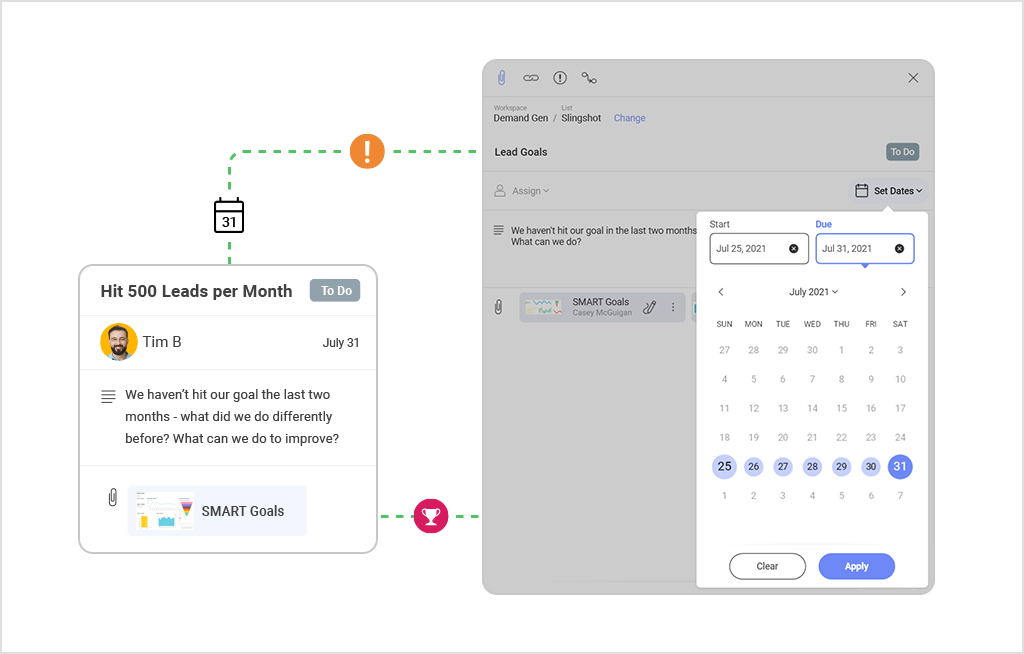
То have an even better understanding of how to utilize this technique efficiently, keeping all the tasks and goals in one online workspace could prove vital.
Let’s take a look at five SMART goal steps, presented through the prism of Slingshot – the all-in-one app that brings together data-driven insights, collaboration in chat on a task level, and transparency on ownership and steps that need to happen to the goal.
1. Keep an eye on the data you need – to be able to adjust your strategy and course-correct promptly, you need to always be able to find the data. As a business intelligence tool, Slingshot provides dashboards and analytics and helps teams connect to the data in a meaningful way
2. Plan smartly according to your workforce: Slingshot is a project management software, and a planning tool for the team, helping with ownership, and division of tasks
3. Stay specific in the outline of tasks: Each task and subtask in Slingshot has its own description and the app allows for sharing tasks, files, and team workspaces with people within and outside the organization, providing trustworthiness and quick feedback when needed
4. Have discussions in context: Slingshot has chats for every task and all activity of your team is there, united and without a need to hunt or comb through different places.
5. Set a timeline and specific due dates: clarity in the timeline of the steps that need to happen is vital in SMART goals setting and helps immensely with prioritization of campaigns, for example
SMART goals usage could well be the difference between make it or break it in milestone achievement. Optioning to use this method through software that supports each pillar of it could bring forth the true success your organization wants.